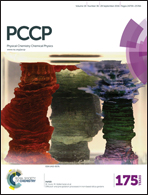Electronic structure of CuTPP and CuTPP(F) complexes: a combined experimental and theoretical study II†
Abstract
The unoccupied electronic structure of thick films of tetraphenylporphyrin and tetrakis(pentafluorophenyl)porphyrin Cu(II) complexes (hereafter, CuTPP and CuTPP(F)) deposited on Au(111) has been studied by combining the outcomes of near-edge X-ray absorption fine structure (NEXAFS) spectroscopy with those of spin-unrestricted time-dependent density functional (TD-DFT) calculations carried out either within the scalar relativistic zeroth order regular approximation (ZORA) framework (C, N and F K-edges) or by using the Tamm–Dancoff approximation coupled to ZORA and including spin–orbit effects (Cu L2,3-edges). Similarly to the modelling of NEXAFS outcomes pertaining to other Cu(II) complexes, the agreement between theory and experiment is more than satisfactory, thus confirming the open-shell TD-DFT to be a useful tool to look into NEXAFS results pertinent to Cu(II) compounds. The combined effect of metalation and phenyl (Ph) fluorine decoration is found to favour an extensive mixing between Phσ* and pristine porphyrin macrocyle (pmc) pmcπ* virtual levels. The lowest lying excitation in the C and N K-edge spectra of both CuTPP and CuTPP(F) is associated with a ligand-to-metal-charge-transfer transition, unambiguously revealed in the CuTPPN K-edge spectral pattern. Moreover, the comparison with literature data pertaining to the modelling of the Cu(II)L2,3 features in the phthalocyanine–Cu(II) (CuPc) complex provided further insights into how metal-to-ligand-charge-transfer transitions associated with excitations from 2pCu(II) AOs to low-lying, ligand-based π* MOs may contribute to the Cu(II) L2,3-edge intensity and thus weaken its believed relationship with the Cu(II)–ligand symmetry-restricted covalency. Despite the coordinative pocket of CuTPP/CuTPP(F) mirroring CuPc, the ligand-field strength exerted by the phthalocyanine ligand on the Cu(II) centre is experimentally found and theoretically confirmed to be slightly stronger than that experienced by Cu in CuTPP and CuTPP(F). On the whole, the obtained results complement those published in the near past by the same group on the occupied and empty states of the H2TPP and H2TPP(F) free ligands as well as on the occupied states of both CuTPP and CuTPP(F), thus providing the final piece to get a thorough description of electronic perturbations associated with the metalation and the Ph halogen decoration of H2TPP.


 Please wait while we load your content...
Please wait while we load your content...